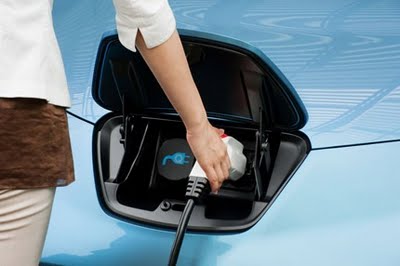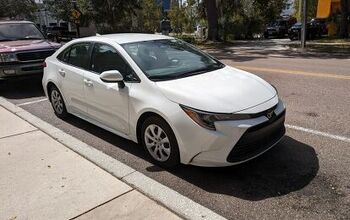Japan Tackles Electric Car Infrastructure Predicaments. Manufacturers Lower Prices

Japan appears to get extremely serious about all-electric cars. What stands in the way of their success? Apart from the price (we’ll get to that later:) It’s the infrastructure, stupid. Fabricating, fuelling, and fixing an ICE-powered car is supported by an infrastructure that had more than 100 years to grow. Keeping a plug-in running needs an infrastructure to guarantee mobility away from the charger at home. Japan’s Environment Ministry teams up with Nissan, Sumitomo, and other companies to build the infrastructure for electric vehicles, reports The Nikkei [sub].
Apart from the most obvious – building charging stations – there are some solutions to questions that haven’t been addressed so far. Don’t worry (or do) those questions will surely come up. For instance, what happens if you are on the road and run out of juice? With an ICE, you can trek to the next gas station, and come back with a gallon or two. With a plug-in? Currently, you need a tow. Think about it. You’ll develop a serious case of range anxiety if you think this through.
To solve that issue, Nissan will develop a truck that will give emergency charges – good for 10km or 6 miles – to electric cars that strayed too far from a plug. Then, drivers can use their car navigation system, co-developed by Nissan and Yasukawa, that shows them the way to the nearest charging station.
Orix Auto will help design a car-sharing system.
Nissan will also test a system for collecting and recycling lithium ion batteries together with NTT Facilities and Sumitomo.
Did we mention price? There is movement on that front also. In a separate story, The Nikkei [sub] sees signs “of an emerging price war in electric vehicles.” Mitsubishi Motors will lower the suggested retail price of its i-MiEV by about 620,000 yen ($6,700.) The new price is 3.98m yen ($43,000.) After generous government subsidies, the car will cost 2.84 million yen ($30,000). Nissan answered that their Leaf electric car, which will come out in December, will cost 2.99 million yen ($32,000) after subsidies are deducted. Jeez, that’s what the car will cost in the U.S.A. before subsidies are deducted.
Mitsubishi just began full retail sales of its i-MiEV. Their planning is conservative. They want to sell 9,000 in the new fiscal year that begins April 1. Nissan is more aggressive. They want to produce about 50,000 Leafs a year in Japan, and plan to begin mass production in the U.S. in 2012 and the U.K. in 2013.
Nevertheless, price remains a serious issue. Said Koji Endo, managing director at Advanced Research Japan: “For electric vehicles to really catch on, the actual cost for consumers needs to be 2 million yen or less.” That would be around $21,000, and sounds about right.
Government subsidies will not last forever. Also in Japan, customers need to wait three to six months until they get their subsidy, which means that they have to front 4 million yen. That and the pesky infrastructure problems will make the all-electric plug-in much less than a run-away hit for the foreseeable future.

Bertel Schmitt comes back to journalism after taking a 35 year break in advertising and marketing. He ran and owned advertising agencies in Duesseldorf, Germany, and New York City. Volkswagen A.G. was Bertel's most important corporate account. Schmitt's advertising and marketing career touched many corners of the industry with a special focus on automotive products and services. Since 2004, he lives in Japan and China with his wife <a href="http://www.tomokoandbertel.com"> Tomoko </a>. Bertel Schmitt is a founding board member of the <a href="http://www.offshoresuperseries.com"> Offshore Super Series </a>, an American offshore powerboat racing organization. He is co-owner of the racing team Typhoon.
More by Bertel Schmitt
Latest Car Reviews
Read moreLatest Product Reviews
Read moreRecent Comments
- MaintenanceCosts You expect everything on Amazon and eBay to be fake, but it's a shame to see fake stuff on Summit Racing. Glad they pulled it.
- SCE to AUX 08 Rabbit (college car, 128k miles): Everything is expensive and difficult to repair. Bought it several years ago as a favor to a friend leaving the country. I outsourced the clutch ($1200), but I did all other work. Ignition switch, all calipers, pads, rotors, A/C compressor, blower fan, cooling fan, plugs and coils, belts and tensioners, 3 flat tires (nails), and on and on.19 Ioniq EV (66k miles): 12V battery, wipers, 1 set of tires, cabin air filter, new pads and rotors at 15k miles since the factory ones wore funny, 1 qt of reduction gear oil. Insurance is cheap. It costs me nearly nothing to drive it.22 Santa Fe (22k miles): Nothing yet, except oil changes. I dread having to buy tires.
- AZFelix 2015 Sonata Limited72k when purchased, 176k miles currentlyI perform all maintenance and repairs except for alignment, tire mounting, tire patching, and glass work (tint and passenger left due to rock hit). Most parts purchased through rockauto.com.Maintenance and repairs during three years of ownership:Front rotors and all brake pads upgraded shortly after purchase.Preparing for 17th oil change (full synthetic plus filter c.$50), one PCV valve.Timing & accessory belts, belt tensioner.Coolant full flush and change.Fibrous plastic material engine under tray replaced by aftermarket solid plastic piece $110.One set of tires (c.$500 +installation) plus two replacements and a number of patches due to nails, etc. Second set coming soon.Hood struts $30.Front struts, rear shocks, plus sway bar links, front ball joints, tie rod ends, right CV axle (large rock on freeway damaged it and I took the opportunity to redo the rest of items on this list).Battery c.$260.Two sets of spark plugs @ $50/set.Three sets of cabin and engine filters.Valve cover gasket (next week).Averages out to c.$1400 per year for the past three years. Minor driver seat bolster wear, front rock chips, and assorted dents & dings but otherwise looks and drives very well.
- 3-On-The-Tree 2014 Ford F150 Ecoboost 3.5L. By 80,000mi I had to have the rear main oil seal replaced twice. Driver side turbo leaking had to have all hoses replaced. Passenger side turbo had to be completely replaced. Engine timing chain front cover leak had to be replaced. Transmission front pump leak had to be removed and replaced. Ford renewed my faith in Extended warranty’s because luckily I had one and used it to the fullest. Sold that truck on caravan and got me a 2021 Tundra Crewmax 4x4. Not a fan of turbos and I will never own a Ford again much less cars with turbos to include newer Toyotas. And I’m a Toyota guy.
- Duke Woolworth Weight 4800# as I recall.


































Comments
Join the conversation
People will adjust behaviorally to the range thing, they'll plug in where-ever they can, and they won't get stuck. Well, most of them won't. But it will kill a lot of spontaneity. And teenagers and young adults will get stuck. I had a nightmare once about a world of electric cars. @JMO: so let Hawaiians drive EVs! (with apologies to Marie Antoinette)
There is a cure for range anxiety: http://www.evnut.com/rav_longranger.htm